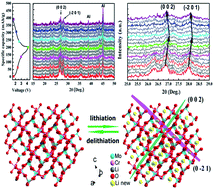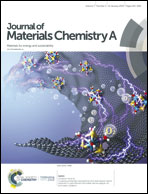LiCr(MoO4)2: a new high specific capacity cathode material for lithium ion batteries†
Abstract
Molybdate polyanion cathode materials have received lots of research interest for their high specific capacity, high cycling stability and interesting physical and chemical properties. Here, LiCr(MoO4)2, a new deintercalation–intercalation type cathode material for lithium ion batteries, is synthesized and studied. Ultraviolet-visible-near-infrared diffuse reflection, density functional theory calculation and four-probe measurement results suggest that LiCr(MoO4)2 possesses a narrow band gap and high electronic conductivity. Bond-valence-sum maps calculation and electrochemical impedance spectroscopy prove the fast lithium ion transport rate of LiCr(MoO4)2. Benefiting from these advantages, LiCr(MoO4)2 delivers a high specific capacity (250 mA h g−1) and good rate performances. The electrochemical reaction mechanism is studied by in situ X-ray diffraction, which indicates that the lithium ion deintercalation–intercalation is a solid solution process with Cr3+/2+ and Mo6+/5+ redox.

- This article is part of the themed collection: 2019 Journal of Materials Chemistry A HOT Papers


 Please wait while we load your content...
Please wait while we load your content...